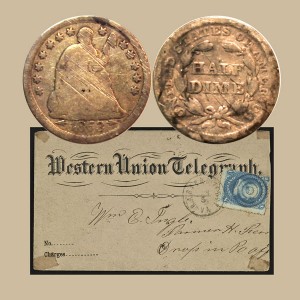Today, the Seated Liberty Half Dime Silver Coin tells the story of the first transcontinental telegraph service that began operation 155 years ago.
From the Publications of the Historical Society of Southern California, Volume 9, published in 1914:
=====
As early as 1858 the idea of a transcontinental line was projected, and two rival companies started work.
The Pacific Atlantic Company pushed its lines southward along the Butterfield overland route via San Jose and reached Los Angeles in 1860 and stopped work.
A central line started by the Placerville Humboldt Company reached Carson City in the spring of 1859, and soon afterwards Ft. Churchill.
To stimulate the effort, the California Legislature offered $6000 a year to the company who would be the first to complete the overland line, but neither company succeeded, and both became merged with the California State Telegraph Company.
In the meanwhile the many eastern companies which had organized and built various lines were undergoing a process of consolidation.
The Western Union Telegraph Company, by obtaining control of the patents of the Morse invention and the House printing machine, soon became the strongest rival in the field, and one by one most of the other companies leased their lines to the new company or else became merged with it.
One of the leading men of the Western Union at the time was Hiram Sibly, and to his wisdom and tireless energy belongs much of the credit for the building of the first line to the Pacific Coast.
Mr. Sibley first presented the scheme to his own board of directors at Rochester, New York, but the risks were thought to be too hazardous to undertake, so the company refused to carry out the project.
It was suggested, however, that the work might be undertaken by an outside organization in which the company might be represented.
Then if the work failed, it would not seriously cripple the whole company, and this plan was carried out.
In 1860 Mr. Sibley applied to Congress for help in the undertaking. It was a very opportune time.
The government realized the need of being in close touch with the western forts and the necessity of keeping the whole country together, and in a very short time, June 16, 1860, a bill was passed “to facilitate communication between the Atlantic and Pacific States by electric telegraph.”
Congress was to grant an annual subsidy of $40,000 for ten years and a quarter of a section of land for every fifteen miles of line.
For this the telegraph company promised to send government messages free to the above amount, the rate of any message being limited to $3 for every ten words.
Jeptha H. Wade, another prominent figure in the building of the new line, succeeded in consolidating the four lines in California and in obtaining a concession of $100,000 from the state for the work.
It was finally agreed that the California State Telegraph Company and the Western Union Company should extend their lines to Salt Lake and there unite.
On January 11, 1861, the Pacific Telegraph Company was incorporated in Nebraska with a capital stock of $1,000,000 to carry out the contract of the Western Union Company, while on the western coast the Overland Telegraph Company was organized in San Francisco with a capital stock of $1,250,000 to carry out the obligation of the California State Telegraph Company.
The question of route was the first to be decided.
This work was given to Edward Creighton, a well-known line builder, and it was his recommendation that finally led to the selection of the route April 12, 1861, from Omaha to Salt Lake via Fort Kearney, Laramie, South Pass, Forts Crittenden and Churchhill, across the Sierra Nevada mountains to Sacramento and San Francisco.
Mr. Creighton offered to take charge of the work of construction, so he was given the contract for building the eastern section, while Mr. James Gamble, who had done such efficient work in building the first line in California, was given charge of the work in the west.
Two years was the time set by most people as the shortest time possible in which the work could be accomplished, but they had not reckoned with the western spirit or the western energy.
On July 4th, 1861, ground was broken for the erection of the first poles.
To give some idea of the magnitude of the work, Mr. Reid says in his book “The Telegraph in America,” nearly a thousand oxen were found necessary for the transportation of the camps, food, wire and poles.
In California the work was divided into two sections. One started east from Carson City, Nevada, and the other worked west from Salt Lake.
Mr. Stebbins took charge of the work from Salt Lake eastward, four hundred miles and Mr. Creighton the remaining seven hundred miles from Omaha.
It seems almost incredible that the gigantic task was completed in a little over four months, but such was the case.
October 19th, the eastern section was completed, and five days later Mr. Gamble’s work was finished, and the first message flashed across the wire October 24, 1861.*
San Francisco, Cal.,
To his Excellency, the President, Oct. 24, 1861, 7:40 P.M.
Washington, D. C.
I announce to you that the telegraph to California has this day been completed. May it be a bond of perpetuity between the states of the Atlantic and those of the Pacific.
(Signed) Horace W. Carpenter, President Overland Telegraph Company.
*Taken from the War Diary of David Homer Bates, Lincoln’s private telegrapher, 1861-1865. “Oct. 25, 1861. Received the first message today from California.”
=====
The Seated Liberty Half Dime Silver Coin shows with an image of a Western Union Telegraph envelope, circa 1875.
